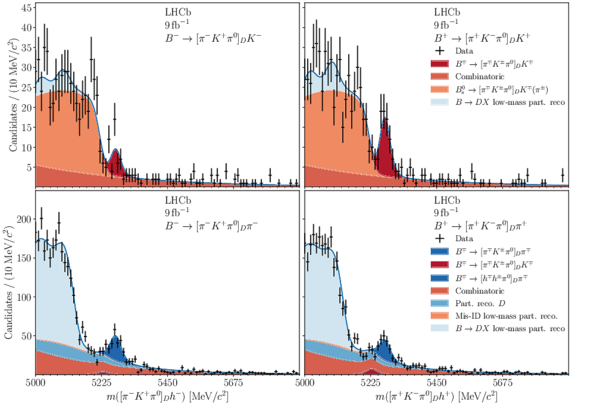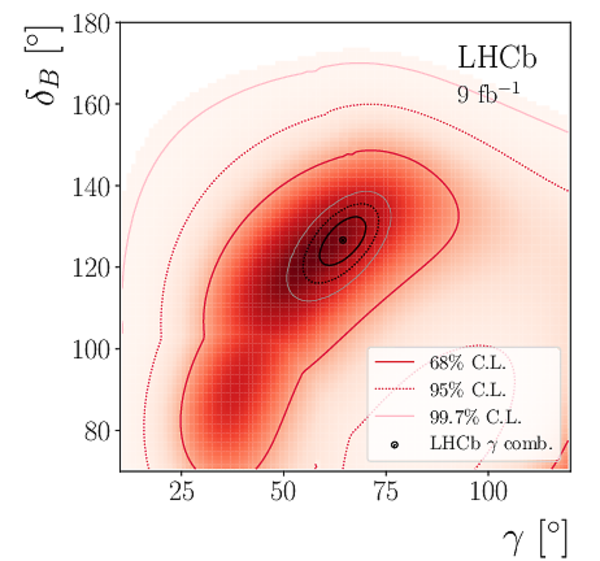Constraints on the CKM angle $\gamma$ from $B^\pm\rightarrow Dh^\pm$ decays using $D\rightarrow h^\pm h^{\prime\mp}\pi^0$ final states
[to restricted-access page]Information
LHCb-PAPER-2021-036
CERN-EP-2021-255
arXiv:2112.10617 [PDF]
(Submitted on 20 Dec 2021)
JHEP 07 (2022) 099
Inspire 1993949
Tools
Abstract
A data sample collected with the LHCb detector corresponding to an integrated luminosity of 9 fb$^{-1}$ is used to measure eleven $CP$ violation observables in $B^\pm\to Dh^\pm$ decays, where $h$ is either a kaon or a pion. The neutral $D$ meson decay is reconstructed in the three-body final states: $K^\pm\pi^\mp\pi^0$}; $\pi^+\pi^-\pi^0$; $K^+K^-\pi^0$ and the suppressed $\pi^\pm K^\mp\pi^0$ combination. The mode where a large $CP$ asymmetry is expected, $B^\pm\to [\pi^\pm K^\mp\pi^0]_DK^\pm$, is observed with a significance greater than seven standard deviations. The ratio of the partial width of this mode relative to that of the favoured mode, $B^\pm\to [K^\pm\pi^\mp\pi^0]_D K^\pm$, is $R_{{\rm ADS}(K)} = (1.27\pm0.16\pm0.02)\times 10^{-2}$. Evidence for a large $CP$ asymmetry is also seen: $A_{{\rm ADS}(K)} = -0.38\pm0.12\pm0.02$. Constraints on the CKM angle $\gamma$ are calculated from the eleven reported observables.
Figures and captions
|
Mass distributions of $ B ^\mp \rightarrow [ K ^\mp \pi ^\pm \pi ^0 ]_D K ^\mp $ (top) and $ B ^\mp \rightarrow [ K ^\mp \pi ^\pm \pi ^0 ]_D\pi ^\mp $ (bottom) candidates, separated by charge. |
Fig1.pdf [320 KiB] HiDef png [409 KiB] Thumbnail [243 KiB] *.C file |

|
|
Mass distributions of $ B ^\mp \rightarrow [\pi ^\mp K ^\pm \pi ^0 ]_D K ^\mp $ (top) and $ B ^\mp \rightarrow [\pi ^\mp K ^\pm \pi ^0 ]_D\pi ^\mp $ (bottom) candidates, separated by charge. |
Fig2.pdf [308 KiB] HiDef png [409 KiB] Thumbnail [260 KiB] *.C file |

|
|
Mass distributions of $ B ^\mp \rightarrow [\pi ^\pm \pi ^\mp \pi ^0 ]_D K ^\mp $ (top) and $ B ^\mp \rightarrow [\pi ^\pm \pi ^\mp \pi ^0 ]_D\pi ^\mp $ (bottom) candidates, separated by charge. |
Fig3.pdf [330 KiB] HiDef png [467 KiB] Thumbnail [267 KiB] *.C file |

|
|
Mass distributions of $ B ^\mp \rightarrow [ K ^\pm K ^\mp \pi ^0 ]_D K ^\mp $ (top) and $ B ^\mp \rightarrow [ K ^\pm K ^\mp \pi ^0 ]_D\pi ^\mp $ (bottom) candidates, separated by charge. |
Fig4.pdf [319 KiB] HiDef png [459 KiB] Thumbnail [269 KiB] *.C file |

|
|
Confidence regions of the strong phase, $\delta_B$ versus the unitarity triangle angle, $\gamma $ shows (left) two solutions, one of which is shown (right) to be consistent with the 2021 $\gamma $ combination result [33] whose confidence intervals are superimposed. |
Fig5a.pdf [306 KiB] HiDef png [1 MiB] Thumbnail [672 KiB] *.C file |

|
|
Fig5b.pdf [316 KiB] HiDef png [1 MiB] Thumbnail [748 KiB] *.C file |

|
|
|
Animated gif made out of all figures. |
PAPER-2021-036.gif Thumbnail |

|
Tables and captions
|
Signal yields for each decay mode. The uncertainties quoted are statistical only. |
Table_1.pdf [66 KiB] HiDef png [123 KiB] Thumbnail [61 KiB] tex code |

|
|
Systematic uncertainties on the observables, multiplied by $10^4$. PID refers to the fixed PID efficiencies of the companion tracks. PDFs refers to the uncertainties in fixing parameters in the fit PDF. Sim refers to the use of simulation to calculate relative efficiencies between the $ B ^- \rightarrow D K ^- $ and $ B ^- \rightarrow D \pi ^- $ modes. $A_{\rm instr}$ refers to the interaction and detection asymmetries. $ D $ decay refers to the effect of assuming that the distribution of candidates in the $ D $ meson decay phase-space is not sculpted by the selection. The Total column corresponds to the quadrature sum over the five categories. |
Table_2.pdf [69 KiB] HiDef png [102 KiB] Thumbnail [48 KiB] tex code |

|
|
Correlation matrix for statistical uncertainties. |
Table_3.pdf [42 KiB] HiDef png [39 KiB] Thumbnail [16 KiB] tex code |

|
|
Correlation matrix for systematic uncertainties. |
Table_4.pdf [42 KiB] HiDef png [41 KiB] Thumbnail [17 KiB] tex code |

|
Created on 02 May 2024.
